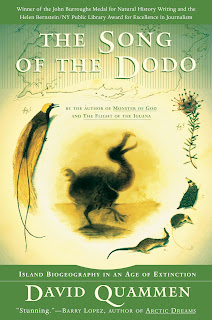After
finishing this book last night, I returned to the beginning: “Let’s start indoors. Let’s start by imagining a fine Persian
carpet and a hunting knife.” So David
Quammen begin this story of how we have arrived from a time of a sprawling
natural world of forest and field, whole and if not perfect then full of
splendor, to a world today that is scattered, pieced, and degraded, though
still yet stunning in places. This book
begins with the names of people that every educated citizen knows—Charles Darwin
and Alfred Russel Wallace—as they began to unravel the mystery of mysteries:
the diversity of life. We followed the
story of their trials and exploration into a world still rich in diversity but
already unravelling so that whole portions are lost. We can feel the sore and blistered feet, and
the risk and inconvenience of getting to the far reaches of the world 160+
years earlier to see what has rarely been seen outside of a small populace of
human inhabitants.
This has been a long telling of the story of the sixth extinction. Could Quammen have simply said: Alas, when the world is cut up into pieces, extinction is the inevitable consequence for many species, especially those that are rare and vulnerable in the first place? Perhaps. However, what a journey he has taken us on and how compelling he made the argument about vulnerability. That “we have entered the era of metapopulations” as the fine Persian carpet has been sliced into fractions, again and again from the Concho water snake, the indri, the muriqui, the original Tasmanians, the thylacine…the list goes on. And, Quammen loves his lists, of course. While the whole world has become a series of isolated patches, in not-quite-islands, so many species are ill equipped to survive this isolation after evolving for millennia unabridged. So many are doomed, we are told, because these small isolated populations have lost the genetic diversity that would permit them to evolve. Speciation halted.
Quammen takes us to a curious place in the end, back to Aru—one of the far-reaching destinations of Wallace’s where he saw the greater bird of paradise, a bird most of us only know in a tacky country song. Quammen leaves us there in Aru with a species that still exists, miraculously, with him staring up at them in a tree calling out with a “chorus of squawking”—a song, that unlike the dodo, we can know. Perhaps this is meant to be a hopeful ending, but I’m not feeling like a hopeful person today: It feels like a last glimpse at what will soon disappear, although we can watch it on YouTube and will not have to guess at least at what it sounded like or looked like. As the book ends, it feels like an ending we have not yet reached, but it is an ending that we can guess. Quammen has laid out the writing on the wall, like a shaman with a compelling vocabulary. The story of extinction will not be a happy conclusion: How can it be?
This has been a long telling of the story of the sixth extinction. Could Quammen have simply said: Alas, when the world is cut up into pieces, extinction is the inevitable consequence for many species, especially those that are rare and vulnerable in the first place? Perhaps. However, what a journey he has taken us on and how compelling he made the argument about vulnerability. That “we have entered the era of metapopulations” as the fine Persian carpet has been sliced into fractions, again and again from the Concho water snake, the indri, the muriqui, the original Tasmanians, the thylacine…the list goes on. And, Quammen loves his lists, of course. While the whole world has become a series of isolated patches, in not-quite-islands, so many species are ill equipped to survive this isolation after evolving for millennia unabridged. So many are doomed, we are told, because these small isolated populations have lost the genetic diversity that would permit them to evolve. Speciation halted.
Quammen takes us to a curious place in the end, back to Aru—one of the far-reaching destinations of Wallace’s where he saw the greater bird of paradise, a bird most of us only know in a tacky country song. Quammen leaves us there in Aru with a species that still exists, miraculously, with him staring up at them in a tree calling out with a “chorus of squawking”—a song, that unlike the dodo, we can know. Perhaps this is meant to be a hopeful ending, but I’m not feeling like a hopeful person today: It feels like a last glimpse at what will soon disappear, although we can watch it on YouTube and will not have to guess at least at what it sounded like or looked like. As the book ends, it feels like an ending we have not yet reached, but it is an ending that we can guess. Quammen has laid out the writing on the wall, like a shaman with a compelling vocabulary. The story of extinction will not be a happy conclusion: How can it be?


